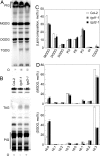A phosphatidic acid-binding protein of the chloroplast inner envelope membrane involved in lipid trafficking
- PMID: 16818883
- PMCID: PMC1502314
- DOI: 10.1073/pnas.0602754103
A phosphatidic acid-binding protein of the chloroplast inner envelope membrane involved in lipid trafficking
Abstract
The biogenesis of the photosynthetic thylakoid membranes inside plant chloroplasts requires enzymes at the plastid envelope and the endoplasmic reticulum (ER). Extensive lipid trafficking is required for thylakoid lipid biosynthesis. Here the trigalactosyldiacylglycerol2 (tgd2) mutant of Arabidopsis is described. To the extent tested, tgd2 showed a complex lipid phenotype identical to the previously described tgd1 mutant. The aberrant accumulation of oligogalactolipids and triacylglycerols and the reduction of molecular species of galactolipids derived from the ER are consistent with a disruption of the import of ER-derived lipids into the plastid. The TGD1 protein is a permease-like component of an ABC transporter located in the chloroplast inner envelope membrane. The TGD2 gene encodes a phosphatidic acid-binding protein with a predicted mycobacterial cell entry domain. It is tethered to the inner chloroplast envelope membrane facing the outer envelope membrane. Presumed bacterial orthologs of TGD1 and TGD2 in Gram-negative bacteria are typically organized in transcriptional units, suggesting their involvement in a common biological process. Expression of the tgd2-1 mutant cDNA caused a dominant-negative effect replicating the tgd2 mutant phenotype. This result is interpreted as the interference of the mutant protein with its native protein complex. It is proposed that TGD2 represents the substrate-binding or regulatory component of a phosphatidic acid/lipid transport complex in the chloroplast inner envelope membrane.
Conflict of interest statement
Conflict of interest statement: No conflicts declared.
Figures





References
-
- Browse J., Somerville C. Annu. Rev. Plant Physiol. Plant Mol. Biol. 1991;42:467–506.
-
- Roughan P. G., Slack C. R. Annu. Rev. Plant Physiol. 1982;33:97–132.
-
- Benning C., Ohta H. J. Biol. Chem. 2005;280:2397–2400. - PubMed
Publication types
MeSH terms
Substances
Associated data
- Actions
LinkOut - more resources
Full Text Sources
Other Literature Sources
Molecular Biology Databases

